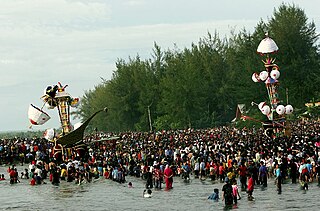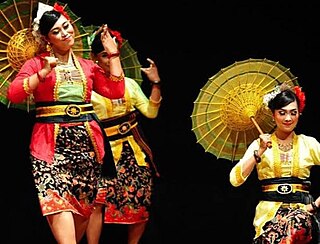
Minangkabau people, also known as Minang, are an Austronesian ethnic group native to the Minangkabau Highlands of West Sumatra, Indonesia. The Minangkabau's West Sumatera homelands was the seat of the Pagaruyung Kingdom, believed by early historians to have been the cradle of the Malay race, and the location of the Padri War.

Riau is a province of Indonesia. It is located on the central eastern coast of the island of Sumatra, and extends from the eastern slopes of the Barisan Mountains to the Malacca Strait, including several large islands situated within the Strait. The province shares land borders with North Sumatra to the northwest, West Sumatra to the west, and Jambi to the south, and a maritime border with the Riau Islands and the country of Malaysia to the east. It is the second-largest province in the island of Sumatra after South Sumatra, and is slightly larger than the nation of Jordan. According to the 2020 census, Riau had a population of 6,394,087 across a land area of 89,935.90 km²; the official estimate of population as of mid-2023 was 6,642,874. The province comprises ten regencies and two cities, with Pekanbaru serving as the capital and largest city.

West Sumatra is a province of Indonesia. It is on the west coast of the island of Sumatra and includes the Mentawai Islands off that coast. West Sumatra borders the Indian Ocean to the west, as well as the provinces of North Sumatra to the north, Riau to the northeast, Jambi to the southeast, and Bengkulu to the south. The province has an area of 42,119.54 km2 (16,262.45 sq mi), or about the same size as Switzerland, with a population of 5,534,472 at the 2020 census. The official estimate at mid 2023 was 5,757,210. The province is subdivided into twelve regencies and seven cities. It has relatively more cities than other provinces outside Java, although several of them are relatively low in population compared with cities elsewhere in Indonesia. Padang is the province's capital and largest city.

The culture of Indonesia has been shaped by the interplay of indigenous customs and diverse foreign influences. With over 600 distinct ethnic groups, including significant Austronesian and Melanesian cultures, contributing to its rich traditions, languages, and customs, Indonesia is a melting pot of diversity. Positioned along ancient trade routes between the Far East, South Asia, and the Middle East, the country has absorbed cultural practices influenced by Hinduism, Buddhism, Confucianism, Islam, and Christianity. These influences have created a complex cultural tapestry that often differs from the original indigenous cultures.

Talempong is a traditional musical instrument of the Minangkabau people of Western Sumatra, Indonesia. The talempong produce a static texture consisting of interlocking rhythms.

A Tabuik is the local manifestation of Remembrance of Muharram, in particular Shiite Ashura, among the Minangkabau people in the coastal regions of West Sumatra, Indonesia, particularly in the city of Pariaman.

Dance in Indonesia reflects the country's diversity of ethnicities and cultures. There are more than 600 ethnic groups in Indonesia. Austronesian roots and Melanesian tribal forms are visible, and influences ranging from neighboring Asian and even western styles through colonization. Each ethnic group has its own dances: there are more than 3,000 original dance forms in Indonesia. The old traditions of dance and drama are being preserved in the numerous dance schools which flourish not only in the courts but also in the modern, government-run or supervised art academies.

The Indang is a form of traditional Indonesian (Minangkabau) art performance originating from West Sumatra, Indonesia. Indang dance grows and develops in the Minangkabau community as a portrayal of the arrival of Islam in West Sumatra in the 13th century.

Tanggai dance is an Indonesian traditional dance performed to welcome people in the weddings. Tanggai dance is Palembangnese traditional dance performed to welcome honorable guests and people in formal events or weddings. In 1965, Tanggai dance was created by Mrs. Elly Rudy (76), the South Sumatran Dance Maestro and the Indonesian Dance Legend, after the banning of Gending Sriwijaya Dance and Dong, the Welcome Dance which also uses long finger nails and carries a small wooden box, for political reasons. In 1965, in Jakarta, on the initiative of the late Raden Husin Natodirajo and Mgs. Nungcik Asaari, both were the two famous Palembang cultural figures, Mrs. Elly Rudy created Tanggai Dance carrying tepak and wearing tanggai. This dance is also functioned as the Welcome Dance to welcome the arrival of noble guests who came to visit Palembang. This has been reinforced by the late Palembang cultural observer R. Johan Hanafiah. So, Mrs. Elly Rudy created a dance entitled Tari Tanggai using the song "Enam Saudara". The dance is practiced in Palembang.

Sewar refers to a dagger of Indonesian origin, typically carried in a belt and used mainly in Sumatra, Indonesia. The blade is also referred to as Sewah by the Gayo people, Seiva by the Minangkabau people, Siva by the Alas people, and Siwaih by the Acehnese people.

The Piring is a traditional Minangkabau plate dance originated and performed in West Sumatra, Indonesia. It is also performed by the Minangkabau diaspora across the globe. The dance might be performed by a group of women, men, or couples; each of whom holds a plate in each hand, and vigorously rotates or half rotates them in various formations and fast movements.

Gending Sriwijaya is the name of the traditional performance whether it is a song, music, as well as dance that originated from Palembang, South Sumatra, Indonesia. Both of the song and the dance was created to describes the splendor, cultural refinement, glory and the grandeur of Srivijaya empire that once succeed on unifying the western parts of Indonesian archipelago and Malay world generally.

The Lilin dance is a traditional Indonesian (Minangkabau) dance performed by a group of dancers to the accompaniment of a group of musicians. The dancers carry lit candles on plates held on the palm of each hand. The dancers dance in groups, rotating the plates at a horizontal plane.
Rudat dance is a traditional dance of Sasak people in Lombok, West Nusa Tenggara, originated from Indonesia. This dance demonstrates pancak silat martial art movements. Rudat dance might be performed by a group costumed and dressed up like prajurit (warrior) with a songkok.

Payung dance is a folk dance-drama tradition of the Minangkabau-Malay ethnic group in Sumatra, Indonesia. This dance is a Minangkabau version of other Malay dances from Sumatra. Folk theatre such as toneel and sandiwara often incorporates payung dance as part of the show. The payung (umbrella) is the main prop used in this dance, and the dance itself, which is usually performed by three or four dancers, symbolizes affection and the relationship of young people. The dance originates from Western Sumatra, Indonesia.

Minangkabau culture is the culture of the Minangkabau ethnic group in Indonesia, part of the Indonesian culture. This culture is one of the two major cultures in the Indonesian archipelago which is very prominent and influential.

Music of Minang is a traditional and contemporary ethnic variety of Indonesian music that grows and develops in the Minangkabau culture. Music is generally played by musical instruments such as talempong, saluang, Minang rabab, serunai, rebana, aguang (gong), gandang, gambus, and violin. However, for traditional events such as weddings, Islamic rebana or gambus are never used.

Baksa Kembang is one of the classical Banjar dances originating from South Kalimantan, Indonesia, which functions as a welcoming dance for guests. This dance is usually played by female dancers with the condition that the number of dancers must be odd.

Kebagh dance, formerly known as the Semban Bidodari, is a traditional Palembang dance originating in Pagaralam, South Sumatra, Indonesia. This dance is characterized by the movement of opening both hands, such as spreading wings, and is usually performed to welcome distinguished guests in traditional ceremonies.


























